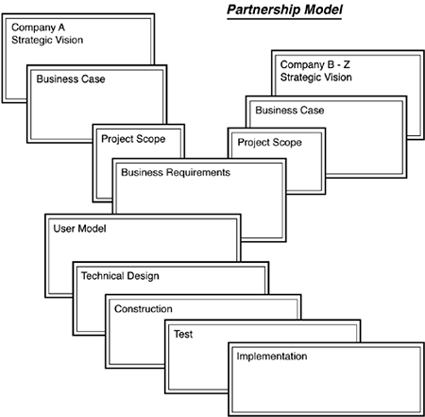Partnership Model
The best way to enter into projects with vendors is to set up a relationship as partners with the vendor. The partnership model is based on open communications, trust, and the ability to benefit from the unique contributions of each individual. As Figure 16.4 shows, the partnership model provides a map for the integration of two or more parties, whether companies, provider and client, or partners in strategic alliance.
Figure 16.4. The partnership model supports the integration of two or more parties.

The partnership model is also effective in providing the reengineering and process improvement that is often a central component of the CRM initiative. It defines the required steps that partners will follow, indicating where those steps are separate and where they overlap.
Strategic Vision
The model starts at the level of defining strategic vision for both parties, whether of company strategy, product strategy, or market strategy. This step is performed separately, but certainly results can be shared and can inspire the parties to find synergies between similar visions. It includes
- Understanding your goals and parameters for the project in question
- Defining the target customer or audience demographics
- Initiating the marketing strategy
- Delineating the expected budget range
Business Case
The next step is the business case, which elaborates the economic models to explore the anticipated costs and benefits of the project or collaboration. This step also includes the review of statistical information on the use of current products and services and of competitor's products and services. The goal of this review is validating the direction of the product or service strategy.
Project Scope
Project scope is evaluated next, and boundaries are drawn in terms of what is in-scope and what is out-of-scope. Defining the scope helps clarify the goals, parameters, and focus of a project so that subsequent changes and additions can be recognized and evaluated before being added.
Business Requirements
The definition of business requirements is the first overlapping step in the partnership model. A more specific vision is developed, indicating data needs, data definitions, process specifications, object and event models, and target customers. The parties will build a joint list of project requirements, and establish the initial project approach plan at this stage. Customer value assessments also begin at this stage. Partners can employ surveys or interviews with potential customers to learn about how they assess the value of an offering.
The remaining steps in the process have a joint focus, whether one or both parties actually perform the steps. This shared focus clarifies the singular outcome expected from the process of working together.
User Model
The user model defines the user interface, which can consist of an Internet site design, online graphical user interface screens, queries, reports, and other outputs such as cases or knowledge content. Use cases help capture all the scenarios depicting how the project will be used when implemented.
Component Design
Next, the partners define the logical components needed to develop the project deliverables and support the business processes required. They define the technical architecture requirements, logical data model, and sources of required information. Working together, they decide on the features the project will implement and the options for doing so. They also define the human resources that will be required by the project and work together to locate and select appropriately skilled service providers for every stage of the project.
Required technology will be defined, including platform selection (development language and application, database, and Web servers) and tools and techniques for development. Partners will also identify any needed vendors for the project, from data providers to other services.
Development estimates of time and cost are finalized at this stage, and a release strategy is put in place. The release strategy should be characterized by short development cycles (average three months), prioritization of needs, and the use of reusable components which enable the parties to benefit from prior experiences on similar projects.
Construction
The construction phase includes the development of any components, program code, and executables that are needed to implement the design. Unit testing occurs on each component at this stage. Whether one or both partners are involved in actual construction, the planning and management should be done cooperatively.
Test
The test program must also be managed jointly, covering seven different dimensions of system performance, including
Implementation
Ongoing monitoring and support provide follow up on the project's performance and help in defining subsequent releases to update and accomplish both parties' vision over time.
